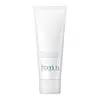What's inside
What's inside
 Key Ingredients
Key Ingredients

 Benefits
Benefits

 Concerns
Concerns

 Ingredients Side-by-side
Ingredients Side-by-side

Glycerin
HumectantPotassium Cocoyl Glycinate
Water
Skin ConditioningButylene Glycol
HumectantPolyglyceryl-10 Myristate
Skin ConditioningDisodium Lauryl Sulfosuccinate
CleansingGlyceryl Stearate
EmollientCitric Acid
BufferingNiacinamide
SmoothingTuna Extract
Skin ConditioningCnidium Officinale Rhizome Extract
Skin ConditioningCapsicum Annuum Fruit Extract
AntimicrobialDipotassium Glycyrrhizate
HumectantPisum Sativum Extract
Skin ConditioningTriticum Vulgare Germ Extract
Skin ConditioningGlycerin, Potassium Cocoyl Glycinate, Water, Butylene Glycol, Polyglyceryl-10 Myristate, Disodium Lauryl Sulfosuccinate, Glyceryl Stearate, Citric Acid, Niacinamide, Tuna Extract, Cnidium Officinale Rhizome Extract, Capsicum Annuum Fruit Extract, Dipotassium Glycyrrhizate, Pisum Sativum Extract, Triticum Vulgare Germ Extract
Butylene Glycol
HumectantWater
Skin ConditioningMyristoyl Glutamic Acid
Skin ConditioningTea-Cocoyl Alaninate
CleansingDipropylene Glycol
HumectantSodium Taurine Cocoyl Methyltaurate
CleansingCitric Acid
BufferingHydroxypropyl Starch Phosphate
Lauric Acid
CleansingGlyceryl Stearate Se
EmulsifyingPolyquaternium-22
Niacinamide
SmoothingZiziphus Jujuba Seed Extract
Skin ConditioningCnidium Officinale Rhizome Extract
Skin ConditioningCitrus Sinensis Peel Extract
PerfumingGlycyrrhiza Glabra Leaf Extract
Skin ConditioningPrunus Persica Fruit Extract
AbrasiveCoix Lacryma-Jobi Ma-Yuen Seed Extract
Skin ConditioningButylene Glycol, Water, Myristoyl Glutamic Acid, Tea-Cocoyl Alaninate, Dipropylene Glycol, Sodium Taurine Cocoyl Methyltaurate, Citric Acid, Hydroxypropyl Starch Phosphate, Lauric Acid, Glyceryl Stearate Se, Polyquaternium-22, Niacinamide, Ziziphus Jujuba Seed Extract, Cnidium Officinale Rhizome Extract, Citrus Sinensis Peel Extract, Glycyrrhiza Glabra Leaf Extract, Prunus Persica Fruit Extract, Coix Lacryma-Jobi Ma-Yuen Seed Extract
Ingredients Explained
These ingredients are found in both products.
Ingredients higher up in an ingredient list are typically present in a larger amount.
Butylene Glycol (or BG) is used within cosmetic products for a few different reasons:
Overall, Butylene Glycol is a safe and well-rounded ingredient that works well with other ingredients.
Though this ingredient works well with most skin types, some people with sensitive skin may experience a reaction such as allergic rashes, closed comedones, or itchiness.
Learn more about Butylene GlycolCitric Acid is an alpha hydroxy acid (AHA) naturally found in citrus fruits like oranges, lemons, and limes.
Like other AHAs, citric acid can exfoliate skin by breaking down the bonds that hold dead skin cells together. This helps reveal smoother and brighter skin underneath.
However, this exfoliating effect only happens at high concentrations (20%) which can be hard to find in cosmetic products.
Due to this, citric acid is usually included in small amounts as a pH adjuster. This helps keep products slightly more acidic and compatible with skin's natural pH.
In skincare formulas, citric acid can:
While it can provide some skin benefits, research shows lactic acid and glycolic acid are generally more effective and less irritating exfoliants.
Most citric acid used in skincare today is made by fermenting sugars (usually from molasses). This synthetic version is identical to the natural citrus form but easier to stabilize and use in formulations.
Read more about some other popular AHA's here:
Learn more about Citric AcidWe don't have a description for Cnidium Officinale Rhizome Extract yet.
Niacinamide is a multitasking form of vitamin B3 that strengthens the skin barrier, reduces pores and dark spots, regulates oil, and improves signs of aging.
And the best part? It's gentle and well-tolerated by most skin types, including sensitive and reactive skin.
You might have heard of "niacin flush", or the reddening of skin that causes itchiness. Niacinamide has not been found to cause this.
In very rare cases, some individuals may not be able to tolerate niacinamide at all or experience an allergic reaction to it.
If you are experiencing flaking, irritation, and dryness with this ingredient, be sure to double check all your products as this ingredient can be found in all categories of skincare.
When incorporating niacinamide into your routine, look out for concentration amounts. Typically, 5% niacinamide provides benefits such as fading dark spots. However, if you have sensitive skin, it is better to begin with a smaller concentration.
When you apply niacinamide to your skin, your body converts it into nicotinamide adenine dinucleotide (NAD). NAD is an essential coenzyme that is already found in your cells as "fuel" and powers countless biological processes.
In your skin, NAD helps repair cell damage, produce new healthy cells, support collagen production, strengthen the skin barrier, and fight environmental stressors (like UV and pollution).
Our natural NAD levels start to decline with age, leading to slower skin repair, visible aging, and a weaker skin barrier. By providing your skin niacinamide, you're recharging your skin's NAD levels. This leads to stronger, healthier, and younger looking skin.
Another name for vitamin B3 is nicotinamide. This vitamin is water-soluble and our bodies don't store it. We obtain Vitamin B3 from either food or skincare. Meat, fish, wheat, yeast, and leafy greens contain vitamin B3.
The type of niacinamide used in skincare is synthetically created.
Learn more about NiacinamideWater. It's the most common cosmetic ingredient of all. You'll usually see it at the top of ingredient lists, meaning that it makes up the largest part of the product.
So why is it so popular? Water most often acts as a solvent - this means that it helps dissolve other ingredients into the formulation.
You'll also recognize water as that liquid we all need to stay alive. If you see this, drink a glass of water. Stay hydrated!
Learn more about Water